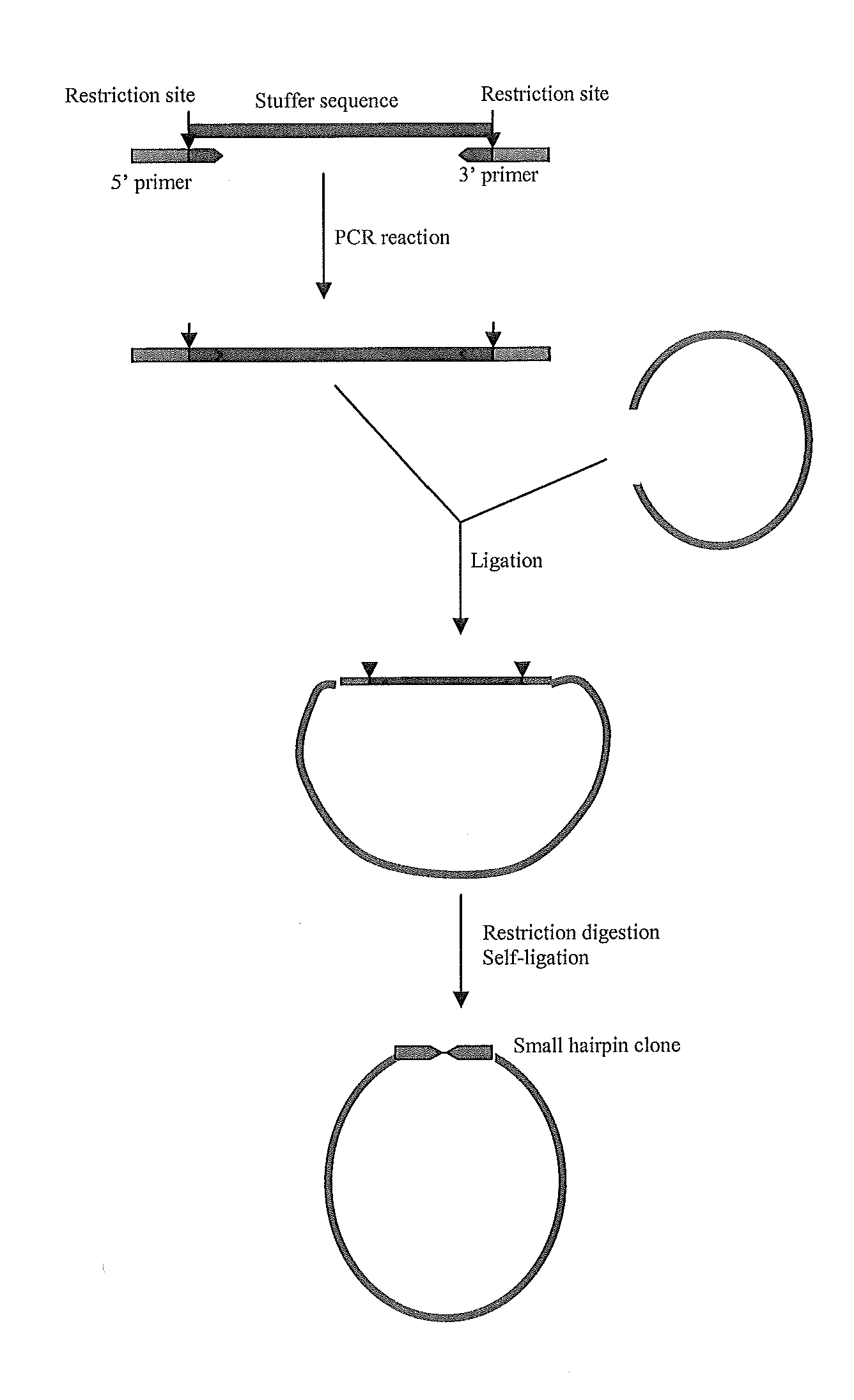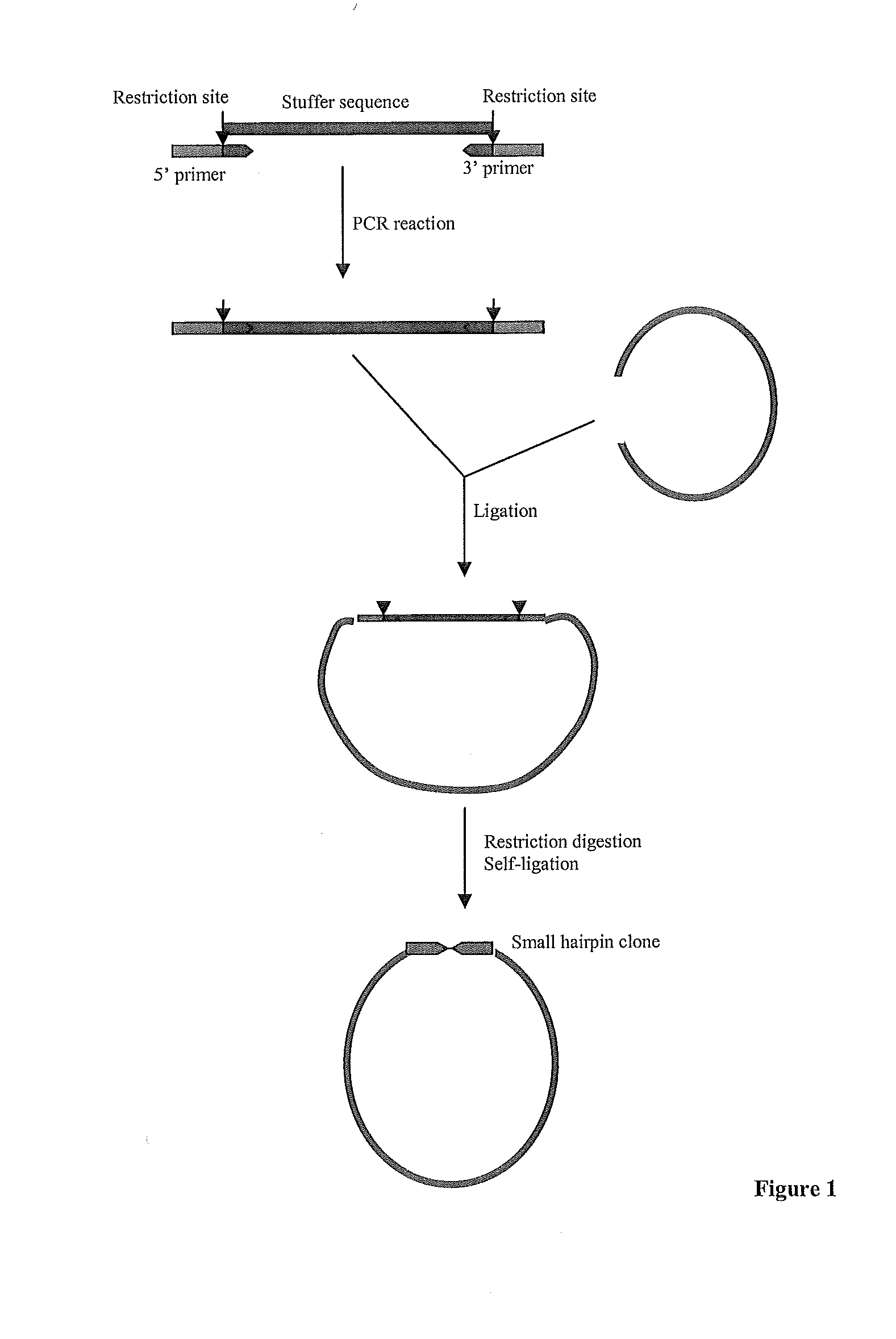EFFICIENT GENE SILENCING IN PLANTS USING SHORT dsRNA SEQUENCES
a technology of short dsrna sequences and efficient gene silencing, which is applied in the field of gene modification of plants, can solve the problems of deficient and insufficient early art of providing methods for highly efficient expression of small molecules, and achieve the effect of high-efficiency expression
- Summary
- Abstract
- Description
- Claims
- Application Information
AI Technical Summary
Benefits of technology
Problems solved by technology
Method used
Image
Examples
example 1
Construction of Type 3 Pol III Promoter—OligodT Stretch Cassettes
[0095]Type 3 Pol III promoters were isolated from Arabidopsis, rice or tomato 7SL, U3snRNA or U6snRNA genes using PCR amplification, designed in such a way that[0096]1) the resulting fragments were flanked by restriction enzyme recognition sites not present within the amplified fragment;[0097]2) the promoter fragments were followed by a unique restriction site (SalI, XhoI or PvuI), followed by[0098]3) a poly(T) sequence (with 7-9 T residues) as Pol III terminator.
In some of the cloned promoter fragments, additional sequences of the coding region downstream of the transcription initiation site were included to investigate the possible effect of conserved motifs in the coding region of the small RNAs on transcription and / or gene silencing. The resulting fragments (represented in SEQ IDs No 1 to 8) were cloned in intermediate cloning vectors (see Table 1). Sense, antisense or inverted repeat sequences can readily be inser...
example 2
Testing of the PolIII Promoters in Gene Silencing Constructs Against a GUS Reporter Gene (Nicotiana tabacum)
[0099]To test these PolIII promoters for silencing, a GUS inverted-repeat sequence (SEQ ID No 9) was synthesized, which consists of 186 bp sense sequence of GUS (nt. 690-875 of GUS coding sequence) fused at the 3′ end with an antisense version of the first 94 bp in the 186 bp fragment (nt. 690-783 of GUS coding sequence). This i / r sequence is flanked by two Sall sites and two Pvul sites, and can therefore be cloned into the PolIII promoter vectors as a SalI or Pvul fragment. Constructs were prepared with all the PolIII promoters described in Table 1 using the i / rGUS sequence (GUShp94) (see Table 2). In addition to the GUShp94 sequence, constructs were also prepared with the AtU3B+136 promoter (SEQ ID No 4.) and the CaMV35S promoter using smaller i / r GUS sequences such GUShp41a (41 bp in the stem spaced by a 9 bp non-GUS sequence; SEQ ID No 10) and GUShp21 (21 bp in the stem sp...
example 3
Testing of the PolIII Promoters in Gene Silencing Constructs Against a GUS Reporter Gene (Arabidopsis thaliana)
[0103]Similar constructs as in Example 2 were generated and cloned in pWBVec4a (see Table 4) and were used to transform a transgenic Arabidopsis line, expressing a CaMV35S-GUS gene.
TABLE 4Summary of constructs tested in ArabidopsisConstructsDescriptionpMBW479GUShp94 driven by 35S promoter (pART7)pMBW480GUShp94 driven by AtU3 + 136pMBW481GUShp94 driven by AtU3pMBW482GUShp94 driven by At7SLpMBW483GUShp94 driven by At7SL + 86pMBW485GUShp94 driven by OsU3pMBW486GUShp94 driven by AtU3 + 3pMBW488GUShp94 driven by AtU3 + 20pLMW62GUShp94 driven by TomU3pLMW56GUShp41 driven by 35S promoterpLMW52GUShp41 driven by AtU3 + 136PLMW60GUShp21 driven by AtU3 + 136
[0104]Leaf tissues from T1 plants that showed high-levels of resistance to the selective agent PPT were assayed for GUS activity. The MUG assay data are summarized in Table 5.
[0105]For the GUShp94 sequence all the U3 and U6 promote...
PUM
| Property | Measurement | Unit |
|---|---|---|
| pH | aaaaa | aaaaa |
| lengths | aaaaa | aaaaa |
| length | aaaaa | aaaaa |
Abstract
Description
Claims
Application Information
 Login to View More
Login to View More - R&D
- Intellectual Property
- Life Sciences
- Materials
- Tech Scout
- Unparalleled Data Quality
- Higher Quality Content
- 60% Fewer Hallucinations
Browse by: Latest US Patents, China's latest patents, Technical Efficacy Thesaurus, Application Domain, Technology Topic, Popular Technical Reports.
© 2025 PatSnap. All rights reserved.Legal|Privacy policy|Modern Slavery Act Transparency Statement|Sitemap|About US| Contact US: help@patsnap.com


